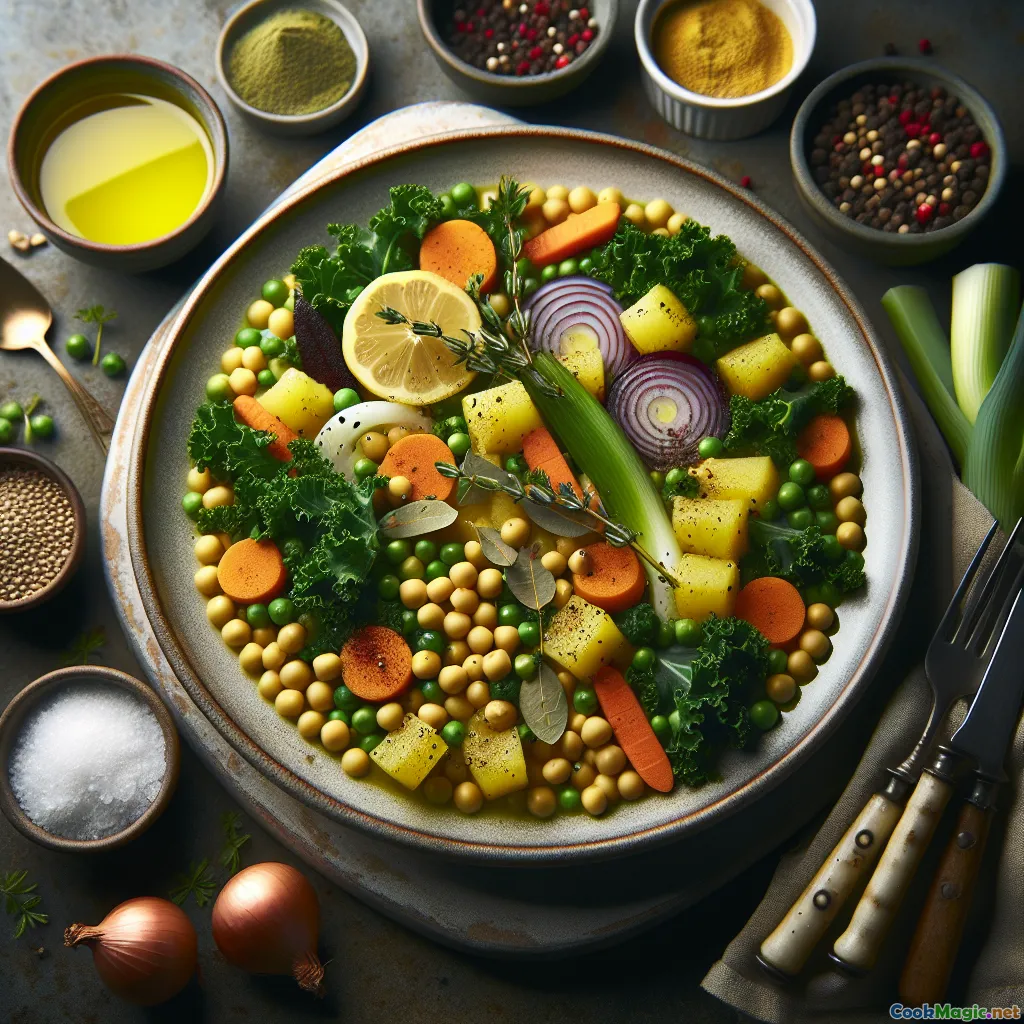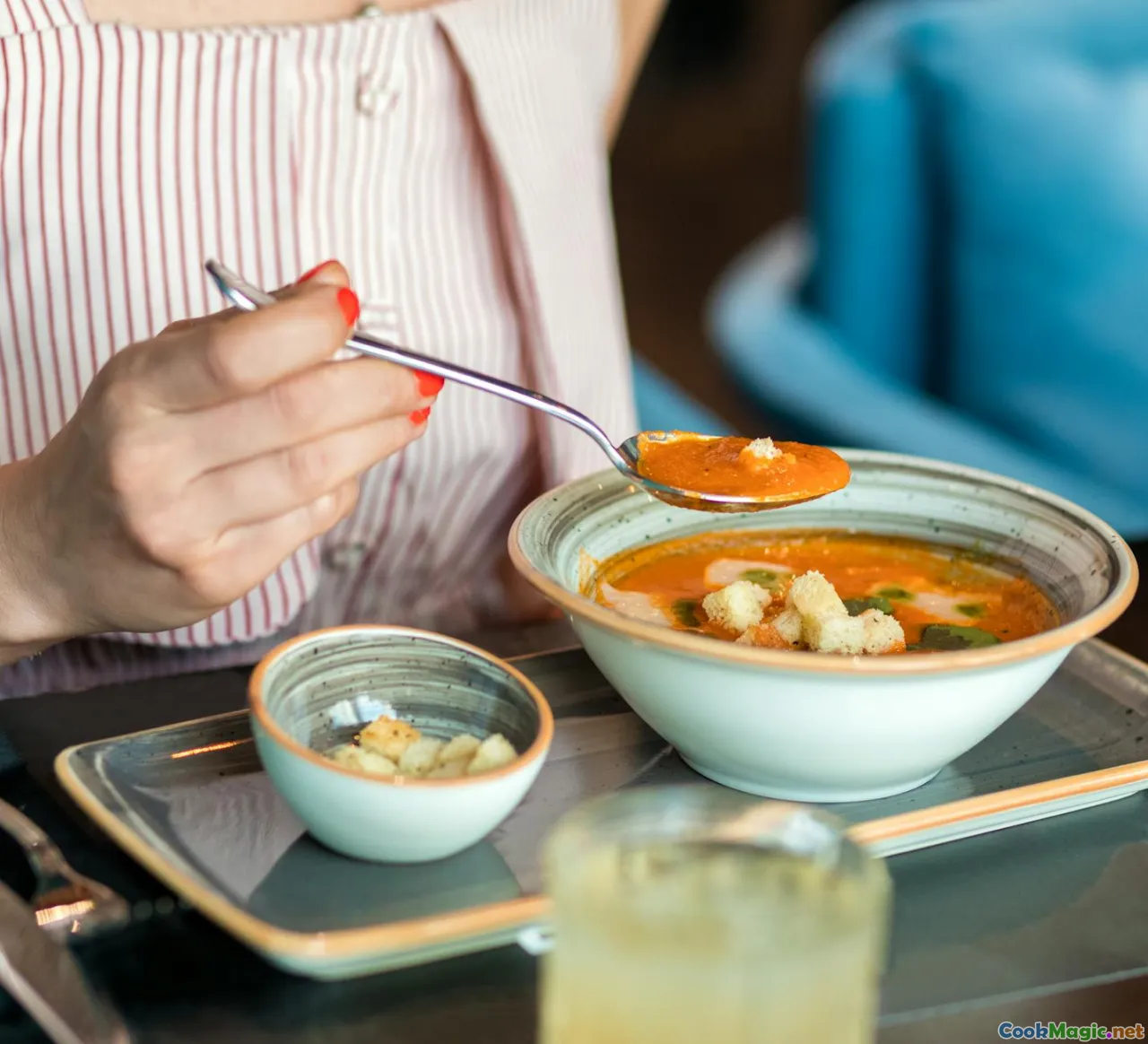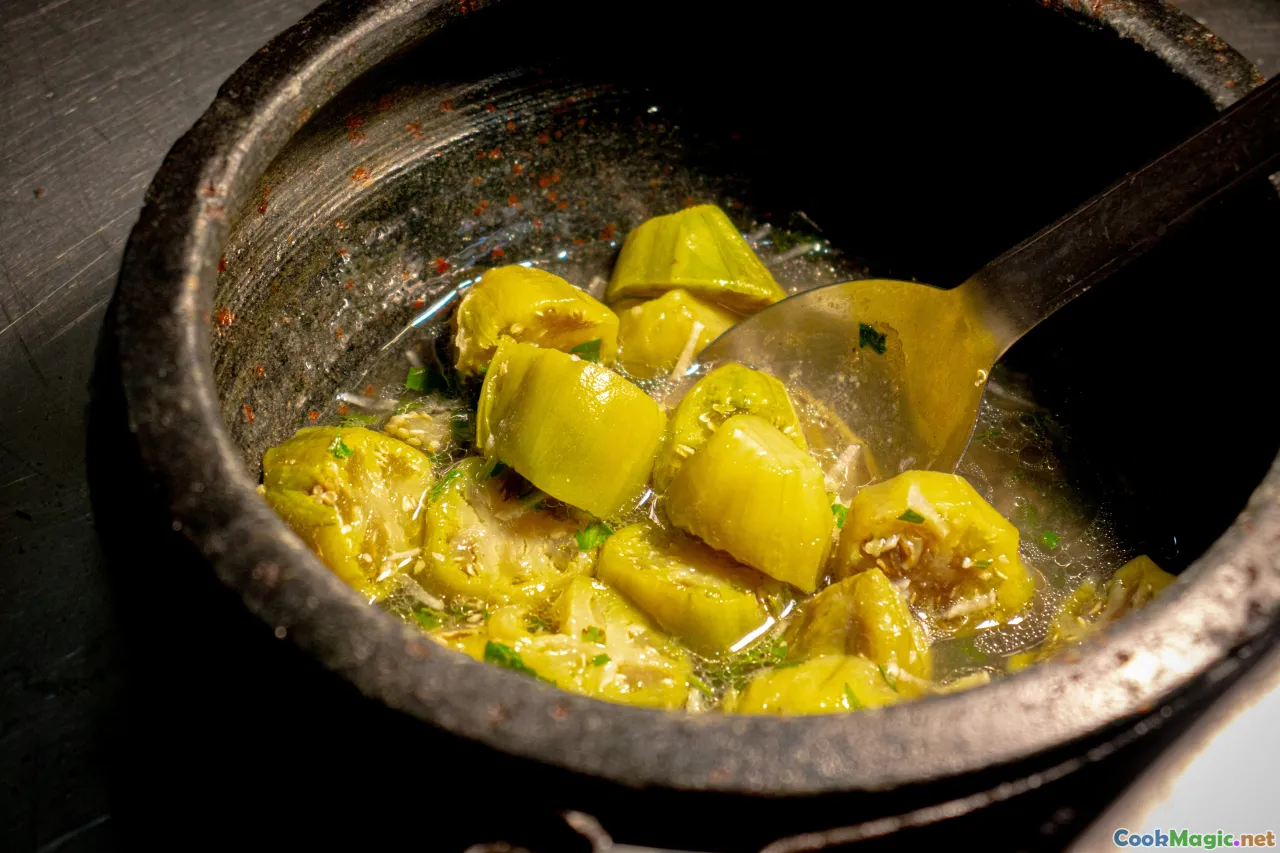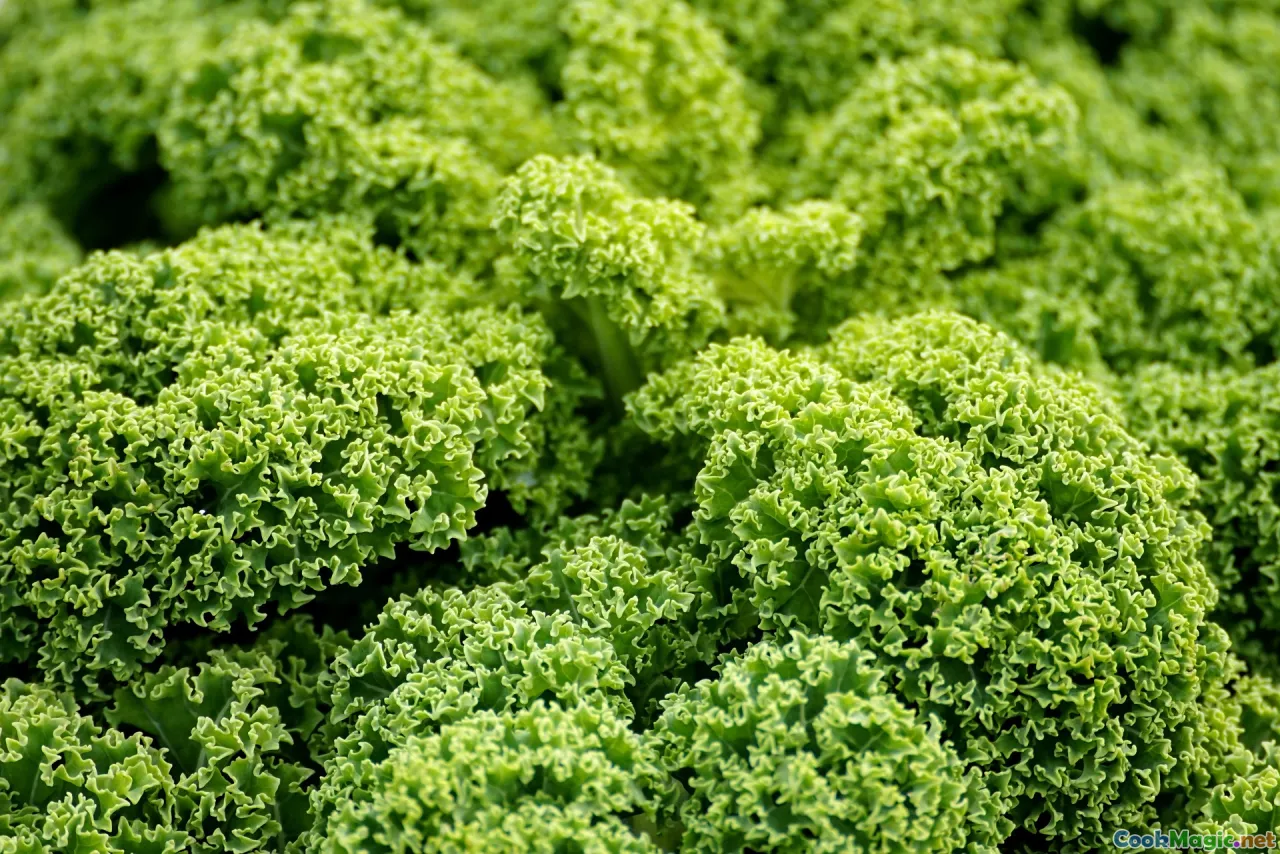
हार्दिक केल और पीली मटर का पोटेज
(Hearty Kale and Yellow Pea Pottage)
(0 समीक्षाएँ)सामग्री
-
300 grams पीला विभाजित मटर
(Rinse thoroughly; soaking 2–4 hours optional to reduce cook time)
-
200 grams कर्ली केल
(Stems removed, leaves chopped)
-
1 large प्याज
(बारीक काटा हुआ)
-
2 medium गाजर
(Diced small)
-
2 stalks सेलरी
(Diced small)
-
300 grams मोटी आलू
(Peeled and cut into 1 cm cubes)
-
1 small प्याज
(Well-cleaned, thinly sliced)
-
4 cloves लहसुन
(कटा हुआ)
-
2 tbsp जैतून का तेल
(एक्स्ट्रा-वर्जिन)
-
1.5 liters सब्जी का स्टॉक
(कम सोडियम वरीयता)
-
2 leaves तेज पत्ते
(परोसने से पहले निकाल दें)
-
1 tsp सूखी थाइम
(Or 1 tbsp fresh thyme leaves)
-
1 tsp स्मोक्ड पेपरिका
(Adds gentle smokiness)
-
1 tsp इंग्लिश सरसों
(For a bright, traditional finish)
-
1 tbsp नींबू का रस
(Or cider vinegar to taste)
-
1 tsp नमक
(स्वादानुसार अधिक डालें)
-
0.5 tsp काली मिर्च
(Freshly ground; add more to taste)
-
60 ml ओट क्रीम
(Unsweetened, for velvety richness)
-
2 tbsp ताजा अजमोद
(कटे हुए, सजाने के लिए)
(Rinse thoroughly; soaking 2–4 hours optional to reduce cook time)
(Stems removed, leaves chopped)
(बारीक काटा हुआ)
(Diced small)
(Diced small)
(Peeled and cut into 1 cm cubes)
(Well-cleaned, thinly sliced)
(कटा हुआ)
(एक्स्ट्रा-वर्जिन)
(कम सोडियम वरीयता)
(परोसने से पहले निकाल दें)
(Or 1 tbsp fresh thyme leaves)
(Adds gentle smokiness)
(For a bright, traditional finish)
(Or cider vinegar to taste)
(स्वादानुसार अधिक डालें)
(Freshly ground; add more to taste)
(Unsweetened, for velvety richness)
(कटे हुए, सजाने के लिए)
पोषण
- परोसने की संख्या: 4
- सेवा आकार: 1 कटोरा (350g)
- Calories: 420 kcal
- Carbohydrates: 0 g
- Protein: 21 g
- Fat: 11 g
- Fiber: 14 g
- Sugar: 7 g
- Sodium: 620 mg
- Cholesterol: 0 mg
- Calcium: 180 mg
- Iron: 5 mg
निर्देश
-
1 - Rinse the peas:
Place yellow split peas in a fine-mesh sieve and rinse under cold water until the water runs clear. If time allows, soak 2–4 hours to reduce simmering time.
-
2 - Prep the Vegetables:
Dice onion, carrots, celery, and potatoes. Slice leek (if using) and mince garlic. Destem kale and chop the leaves into bite-size pieces.
-
3 - Sweat the Aromatics:
Warm olive oil in a heavy pot over medium heat. Add onion, celery, and leek. Cook, stirring, until translucent and sweet, about 6 minutes.
-
4 - Bloom garlic and herbs:
Stir in garlic, dried thyme, and smoked paprika (if using). Cook 30–60 seconds until fragrant to release their oils.
-
5 - Add peas and stock:
Add rinsed peas, bay leaves, and vegetable stock. Stir to combine and bring to a gentle boil.
-
6 - Simmer the peas:
Reduce to a steady simmer, partially cover, and cook until peas begin to soften but are not falling apart. Skim any foam for a clearer broth.
-
7 - Add roots and continue:
Stir in diced potatoes and carrots. Continue simmering until vegetables are tender and peas are creamy around the edges.
-
8 - Wilt the kale:
Add chopped kale and cook until just tender and vibrant green. If too thick, splash in a little hot water or stock.
-
9 - Season and Brighten:
Remove bay leaves. Stir in lemon juice and English mustard. Season with salt and black pepper. Swirl in oat cream, if using.
-
10 - Rest and Serve:
Let the pottage rest a minute for flavors to meld. Ladle into bowls and finish with fresh parsley.
Place yellow split peas in a fine-mesh sieve and rinse under cold water until the water runs clear. If time allows, soak 2–4 hours to reduce simmering time.
Dice onion, carrots, celery, and potatoes. Slice leek (if using) and mince garlic. Destem kale and chop the leaves into bite-size pieces.
Warm olive oil in a heavy pot over medium heat. Add onion, celery, and leek. Cook, stirring, until translucent and sweet, about 6 minutes.
Stir in garlic, dried thyme, and smoked paprika (if using). Cook 30–60 seconds until fragrant to release their oils.
Add rinsed peas, bay leaves, and vegetable stock. Stir to combine and bring to a gentle boil.
Reduce to a steady simmer, partially cover, and cook until peas begin to soften but are not falling apart. Skim any foam for a clearer broth.
Stir in diced potatoes and carrots. Continue simmering until vegetables are tender and peas are creamy around the edges.
Add chopped kale and cook until just tender and vibrant green. If too thick, splash in a little hot water or stock.
Remove bay leaves. Stir in lemon juice and English mustard. Season with salt and black pepper. Swirl in oat cream, if using.
Let the pottage rest a minute for flavors to meld. Ladle into bowls and finish with fresh parsley.
हार्दिक केल और पीली मटर का पोटेज :के बारे में ज़्यादा जानकारी
Hearty Kale and Yellow Pea Pottage
A pottage is more than a soup and not quite a stew—it is a comforting, one-pot meal that anchors a table with its hearty texture and wholesome simplicity. This Kale and Yellow Pea Pottage draws inspiration from English country kitchens, where legumes, brassicas, and root vegetables have long been simmered together to nourish families through cool, damp seasons. The yellow split pea base turns luxuriously creamy as it breaks down, while kale adds earthy depth, chew, and a pop of emerald color. A final whisper of English mustard and lemon brightens the pot, lifting the natural sweetness of onions, carrots, and peas.
Why this pottage works
- Layered flavor: Sweating aromatics builds sweetness, thyme and bay add herbaceous structure, and a touch of smoked paprika (optional) evokes hearth-cooked richness.
- Textural balance: Tender peas and velvety broth contrast with bite-sized vegetables and ribbons of kale.
- Nutritional powerhouse: High in fiber and plant protein, naturally dairy-free and gluten-free. Oat cream enriches without heaviness.
Ingredient spotlight
- Yellow split peas: Favored for their mild, nutty flavor and ability to thicken naturally. Unlike whole dried peas, they cook relatively quickly and usually do not require soaking (though soaking is a helpful time-saver).
- Kale: Curly kale holds its bite; cavolo nero (Tuscan kale) works beautifully too. Add late to preserve color and nutrients.
- English mustard and lemon: A small amount transforms the pot, sharpening flavors the way a squeeze of citrus finishes a rich stew.
Tips, swaps, and variations
- No-soak vs. soak: If unsoaked, simmer peas gently until creamy; soaked peas can shave 10–15 minutes off. Do not boil vigorously, which can split vegetables and cloud the broth.
- Protein boost: Stir in cooked pearl barley (not gluten-free) or quinoa in the last 10 minutes. For omnivores, a few flakes of hot-smoked fish on top is a classic Northern touch.
- Herb choices: Thyme is traditional; rosemary or marjoram provide interesting twists. Fresh herbs are best added toward the end.
- Greens: Swap kale for savoy cabbage, spring greens, or spinach (add spinach just before serving).
- Creaminess: Omit oat cream for a lighter bowl; for extra body, mash a ladleful of peas against the pot and stir back in.
- Heat and smoke: Smoked paprika adds depth; a pinch of chili flakes brings gentle warmth without overwhelming the peas’ sweetness.
- Salt strategy: Season late. Stock and mustard both bring salinity, and peas continue to absorb and concentrate flavors as they rest.
Make-ahead and storage
This pottage is a meal-prep star. It thickens as it cools; loosen with a splash of hot water or stock when reheating.
- Fridge: Up to 4 days in an airtight container.
- Freezer: Up to 3 months. Thaw overnight in the fridge and reheat gently to preserve kale’s color.
History and cultural notes
Pottage is an old English staple, stretching back to medieval times when cauldrons hung over hearths and meals were continually refreshed with whatever was at hand. Pease—dried field peas—were common across Britain because they stored well and provided reliable sustenance through winter. Kale and other hardy greens, thriving in cool climates, were equally essential. This recipe nods to that heritage while refining the flavors for modern palates. You will taste echoes of pease pottage, the dish immortalized in nursery rhyme, yet the lemon and mustard offer a crisp contemporary counterpoint. There’s kinship, too, with Scandinavian yellow pea soups, though this version remains English in spirit and finish.
Serving suggestions
- Rustic bread or oatcakes on the side for dunking.
- A drizzle of good olive oil, extra parsley, or a spoon of oat cream for gloss.
- For non-vegan tables, a shaving of mature cheddar on hot bread complements the pottage’s sweetness and tang.
Sustainability and budget
Dried legumes are among the most affordable, low-waste, and low-footprint proteins available. Kale is hardy, thrives in cool weather, and often comes from local farms well into late autumn and winter. This pot leans on pantry staples, minimizes perishables, and converts modest ingredients into deep satisfaction—an ideal blend of thrift and comfort.
Chef’s notes
The secret to an exceptional pottage lies in pacing: give onions time to turn sweet before adding liquid, simmer peas gently so they become creamy but not mushy, and add kale late to preserve color. Taste repeatedly in the last few minutes; the difference between good and great often comes from an extra pinch of salt, a twist of pepper, or one more squeeze of lemon. Let the pot rest briefly off the heat and the flavors knit together. This is the kind of cooking that rewards attention without demanding urgency—the kitchen equivalent of a wool blanket and a quiet evening.























